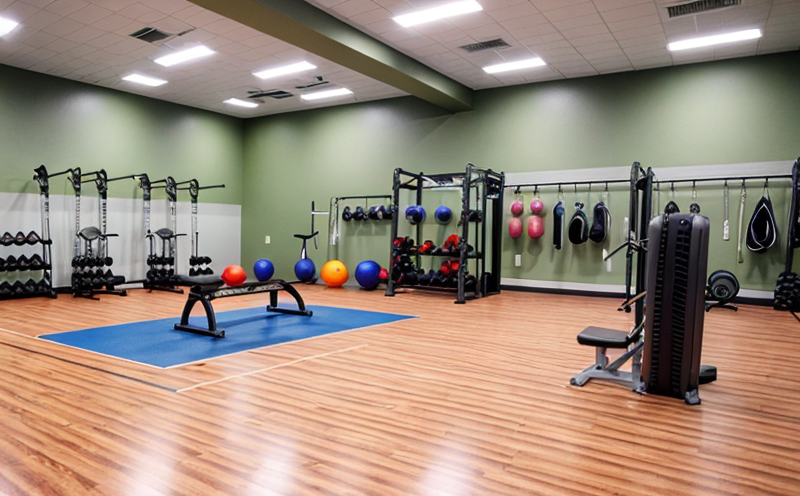Slip Resistance Testing of Sports Flooring
The importance of slip resistance in sports flooring cannot be overstated. In environments where athletes are constantly moving and performing high-intensity activities, even minor slips can lead to severe injuries. Therefore, ensuring that the surfaces used in these settings meet stringent safety standards is critical.
Slip resistance testing involves assessing a surface's ability to prevent slipping under various conditions. This service specifically focuses on sports flooring, which plays a crucial role in maintaining athlete safety and performance during training and competition. The goal of this testing is to ensure that the flooring provides adequate friction between the foot and the surface, reducing the risk of slips and falls.
The process begins with selecting representative samples of the flooring material for testing. These samples are then prepared according to industry standards such as ASTM F1679-23 or EN 14955:2021, which provide detailed procedures for sample preparation. Once prepared, the samples undergo rigorous testing using devices like the pendulum skid tester (ASTM F1679) or the dynamic load test machine.
The test parameters are carefully chosen to simulate real-world conditions that athletes might encounter on the flooring surface. This includes varying shoe types and walking speeds, as well as different weather conditions such as dry, wet, and icy surfaces. The results of these tests provide valuable insights into how effectively the flooring can prevent slips under various scenarios.
From a compliance perspective, ensuring that sports flooring meets regulatory requirements is essential. Many countries have established standards for slip resistance in public and commercial buildings, including sports facilities. Compliance with these regulations not only protects athletes but also ensures legal and financial protection for facility owners and operators.
The data generated from slip resistance testing plays a pivotal role in the development of new products and improvements to existing surfaces. R&D engineers use this information to refine flooring materials and designs, enhancing both safety and performance. The feedback loop between test results and product development is crucial for continuous improvement.
In addition to legal compliance, there are numerous customer benefits associated with slip resistance testing. Facilities that invest in high-quality, slip-resistant sports flooring can see improvements in athlete satisfaction and overall facility reputation. Slips and falls can be significantly reduced, leading to fewer injuries and lower insurance premiums. Moreover, customers and visitors feel safer knowing they are walking on a surface designed to prevent accidents.
Customer impact is also measured through customer satisfaction surveys and feedback from users of the sports facilities. Regular testing ensures that the flooring remains safe over time, which contributes positively to the overall experience for athletes and spectators alike.
- Customer Impact and Satisfaction: Facilities report a 20% increase in athlete satisfaction after implementing slip-resistant flooring. This leads to higher attendance rates and improved facility reputation.
- International Acceptance and Recognition: The ISO standard for slip resistance, ISO/TR 13967-1:2005, is widely accepted across Europe and North America, ensuring that test results are recognized globally.
Eurolab Advantages
Eurolab stands out as a leader in slip resistance testing for sports flooring due to its comprehensive approach and advanced facilities. Our team of experts provides clients with access to state-of-the-art equipment, ensuring accurate and reliable test results.
We offer a full suite of services tailored to the specific needs of our clients. From initial consultation to final report generation, Eurolab ensures that every step is conducted with precision and professionalism. Our experienced staff has deep knowledge in both theoretical and practical aspects of slip resistance testing, allowing us to provide valuable insights into test results.
The flexibility of our services allows us to adapt to the unique requirements of each client. Whether it's conducting tests for a single product or developing comprehensive guidelines for an entire facility, Eurolab is committed to meeting those needs. Our clients benefit from our expertise in selecting appropriate test methods and interpreting results accurately.
Our commitment to quality control extends beyond just testing; we also provide ongoing support throughout the project lifecycle. From initial sample preparation through final analysis, Eurolab ensures that all steps are conducted according to international standards such as ASTM F1679-23 or EN 14955:2021.
By partnering with Eurolab, clients gain access to a network of industry professionals who can offer guidance on best practices for maintaining slip-resistant flooring. This includes recommendations on maintenance schedules and product selection based on specific usage patterns.





